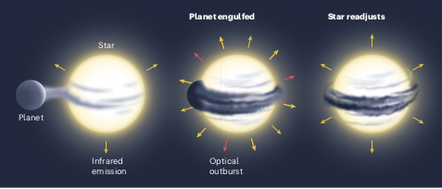Ten-day optical burst shows star eating giant planet, scientists say
Twelve-year interaction ended with a bang
Scientists have concluded that an unexplained optical burst from the Milky Way galaxy provides evidence of a star eating up its local giant planet.
MIT post-doctoral fellow Kishalay De and his colleagues first noticed anomalies with ZTF SLRN-2020, a star 12,000 light-years away, near the eagle-like constellation Aquila in the Milky Way, according to a research paper in Nature this week.
The initial data came from the Zwicky Transient Facility (ZTF), run at Caltech’s Palomar Observatory in California, and showed the stars that rapidly change in brightness, the pattern of which could be signatures of supernovae, gamma-ray bursts, and other stellar phenomena.
Hoping to nail down the source with more data, De et al looked to observations of the same star taken by the Keck Observatory in Hawaii. The Keck telescopes take spectroscopic measurements of starlight, which scientists can use to discern a star’s chemical composition.
What they found offered evidence of a destructive interaction between a star and a planet astronomers had long suspected but never observed. The authors first compared the outburst with transients known as dwarf and classical novae, which are often observed in the galactic disk.
“However, the authors found that the outburst resembled a red nova. Red novae are red-hued astronomical objects that emit slowly fading infrared radiation, and it has been suggested that they are associated with the merging of two stars,” explained Smadar Naoz, of the University of California, Los Angeles, in an accompanying article.
Yet further investigation revealed that the luminosity of ZTF SLRN-2020 was much lower than for other red novae, suggesting that an object smaller than a star was involved in the merger event, she said.
“From the source’s brightness as a function of time and from observations before the outburst, they inferred that the mass of its merging companion was roughly that of Jupiter or Neptune. The story of the event, therefore, began to unfold: a giant planet had ventured too close to its parent star, interacting with it for a while before the outburst, which probably correlated with the engulfment of the planet by the star,” Naoz said.
The authors’ observation of dust and gas from before the outburst suggests that the interaction lasted between six and 12 years.
In a statement released by MIT, De said: “For decades, we’ve been able to see the before and after.
- Space: The final frontier, or the next venture capital gold rush
- Saturn's rings are shrinking and boffins will use the Webb 'scope to find out why
- ESA's Jupiter-bound Juice spacecraft has a sticky problem with its radar
- Metal-rich stars inhibit chances of life on their planets
“Before, when the planets are still orbiting very close to their star, and after, when a planet has already been engulfed, and the star is giant. What we were missing was catching the star in the act, where you have a planet undergoing this fate in real-time. That’s what makes this discovery really exciting.”
Naoz pointed out that computational models showed gravitational interactions between a planet and other objects in the system can slowly push a planet towards its host star.
“Tidal interactions between a star and a planet in close orbit around it can also slowly drive the planet to its demise. As a star exhausts its core hydrogen fuel, it expands and becomes a sub-giant. At this stage, it will start to engulf its nearby planets — in a few billion years, the Sun will undergo this process,” she added cheerfully. ®

